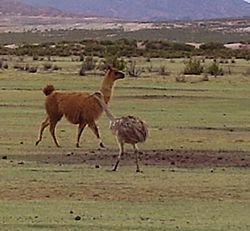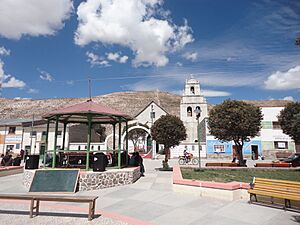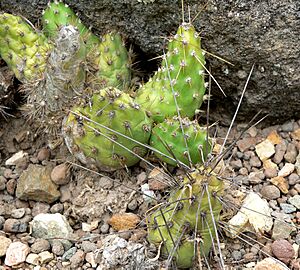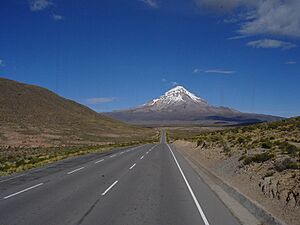Turco Municipality facts for kids
Quick facts for kids
Turco Municipality
Turku
|
|
|---|---|
|
Municipality
|
|

Darwin's rhea (Rhea pennata garleppi) photographed at the Tika Uta ranch, Turco Municipality
|
|
| Country | |
| Department | Oruro Department |
| Province | Sajama Province |
| Cantons | 4 |
| Created | February 15, 1957 |
| Seat | Turco |
| Area | |
| • Total | 1,534 sq mi (3,973 km2) |
| Elevation | 12,660 ft (3,860 m) |
| Population
(2001)
|
|
| • Total | 4,160 |
| • Ethnicities | Aymara |
Turco Municipality is a special area in Bolivia. It's like a local government district. It was created on February 15, 1957. The main town, or "seat," is called Turco. This town is about 154 kilometers (96 miles) west of Oruro. It sits very high up, at 3,860 meters (about 12,664 feet) above sea level! The whole municipality covers a large area of 3,973 square kilometers (1,534 square miles).
Turco Municipality shares its borders with several other areas. To the north, it has the Curahuara de Carangas Municipality and San Pedro de Totora Province. To the south, you'll find the Litoral and Sabaya Provinces. To the west, it borders Chile, and to the east, it's next to the Carangas Province.
Contents
Exploring Turco's Geography
This region has many important rivers. Some of the main ones are Sajama, Cosapa, Lauca, K'uwiri, and Qullpa Jawira. The Qullpa Jawira river is also known as the Turco River.
Mountains and Volcanoes
In the west of the municipality, you'll find parts of the Bolivian Western Mountain Range. This range includes volcanoes and mountains like Uqi Uqini. There's also the volcanic group called Kimsa Chata. This group has three mountains: Umurata, Acotango, and Capurata. These mountains form a natural border between Turco Municipality and Chile.
Here are some other mountains in the area:
- Ari Qullu Phujru
- Asu Asuni
- Chachakumani
- Chilli Qhata
- Chullkani
- Chunkarani
- Chuqil Qamiri
- Ch'alla Willk'i
- Ch'iyar Jaqhi
- Ch'iyar Jaqhi (near Qhapaqa)
- Ch'iyar Jaqhi (Umurata)
- Ch'iyar Qullu
- Jach'a K'uchu
- Jach'a Qullu
- Janq'u Jaqhi
- Janq'u Willk'i
- Kimsa Chata (Sajama)
- Kimsa Misa
- Kiswara
- Kuntur Ikiña
- Liyun Ikiña
- Mamaniri
- Ñuñu Qullu
- Ñuñutani
- Picha Qullu
- Pichaqani
- Pukarani
- Phaq'u Qullu
- Phasa Willk'i
- Q'ara Qullu
- Q'aysiri
- Q'ulin Ch'utu
- Qhapaqa
- Salla Qullu
- Tankani
- Taypi Qullu
- Taypi Qullu (near Junt'u Uta)
- Titiri
- Turi Turini
- Uqi Uqini
- Uqi Uqini (Bolivia)
- Uyarani
- Wankarani
- Warin Uma
- Waylla Sirka
- Wayna Chullunkhäni
- Wayna
- Wichhu Qullu
- Wila Lat'arata
- Wila Qullu (Qutallani)
- Wila Qullu (Turco)
- Willk'i
- Yapu Qullu
- Yaritani
How Turco Municipality is Divided
The municipality is split into four main areas called cantons. It also has nine smaller community groups known as ayllus.
Here's a look at the cantons and their populations from 2001:
| Canton | Created | Inhabitants (2001) |
|---|---|---|
| Asunción Laca Laca | December 21, 1962 | 342 |
| Chachakumani | August 30, 1957 | 374 |
| Cosapa | November 11, 1950 | 918 |
| Turco | July 27, 1951 | 2,526 |
Plants and Animals of Turco

Part of the Cosapa Canton is inside the Sajama National Park. This park was created to protect special plants and animals. It helps save rare trees like the queñua species Polylepis tarapacana. It also protects animals like the Andean hairy armadillo and Darwin's rhea. Other animals found here include the vicuña, taruca, Andean mountain cat, and cougar (also called puma). All these animals live in the Turco Municipality.
Important Plants and Their Uses
The region has many different native plants. These plants are useful for both the people and the animals living there.
Here are some of the most important plant species:
| Common name | Scientific name | Usability |
|---|---|---|
| Añawaya | Adesmia spinosissima | food for llamas |
| Waylla | Stipa obtusa | food for llamas |
| Ichu | Stipa ichu | food, used for crafts |
| Iru ichu | Festuca orthophylla | food, used for crafts |
| Qanlli kiska | Tetraglochin cristatum | food |
| Chillka | Senecio pampae | food, medicine |
| Yarita, yareta | Azorella asorella | medicine, heating fuel |
| Tara tara | Fabiana densa | medicine, heating fuel |
| Ñaka thula | Baccharis incarum | medicine, heating fuel |
| Supu thula | Parastrephya lepidophylla | medicine, heating fuel |
| Ayrampu | Opuntia soehrensii / Tunilla soehrensii | medicine, food |
| Muña muña | Satureja ovata | medicine, food |
| Itapallu | Cajophora horrida | medicine, food |
| Kinwa, queñua | Polylepis tarapacana | food, heating fuel, decorative |
| Chachakuma | Escallonia resinosa | medicine |
| Llapa, pasto bandera | Boutelova simplex | food |
| Yawarilla, cebadilla común | Bromus unioloides | food |
| Cebadilla de montaña | Agrostis breviculmis | food |
| Chiji blanco | Distichlis humilis | food |
| Chiji negro | Mulenbergia fastigiata | food |
| Garbancillo | Astragalus garbancillo | toxic (poisonous) |
| Lampaya | Lampaya medicinalis | medicine, food, heating fuel |
| Qura | Cajophora horrida | food |
| K’achu | Anoda triangularis | food |
The People of Turco
Most people in Turco Municipality are from the Aymara group, known as Carangas. Many of them speak two languages. According to a 2001 census, the main languages spoken are Spanish (by 3,544 people) and Aymara (by 3,259 people).
Getting Around: Transport
A major road that connects Oruro to Chile passes through Turco Municipality. This road leads to Tambo Quemado. Tambo Quemado is located in the Chachacomani Canton, in the northwestern part of the municipality. It's right on the border between Chile and Bolivia.
Turco's Climate
The weather in Turco varies throughout the year. It can get quite cold, especially at night, due to its high elevation.
| Climate data for Turco, elevation 3,859 m (12,661 ft), (1982–2011) | |||||||||||||
|---|---|---|---|---|---|---|---|---|---|---|---|---|---|
| Month | Jan | Feb | Mar | Apr | May | Jun | Jul | Aug | Sep | Oct | Nov | Dec | Year |
| Record high °C (°F) | 24.0 (75.2) |
23.3 (73.9) |
21.8 (71.2) |
23.0 (73.4) |
25.0 (77.0) |
20.1 (68.2) |
21.0 (69.8) |
22.1 (71.8) |
23.5 (74.3) |
23.9 (75.0) |
24.0 (75.2) |
24.0 (75.2) |
25.0 (77.0) |
| Mean daily maximum °C (°F) | 18.3 (64.9) |
19.4 (66.9) |
17.8 (64.0) |
19.3 (66.7) |
17.4 (63.3) |
17.1 (62.8) |
15.7 (60.3) |
17.8 (64.0) |
19.2 (66.6) |
20.7 (69.3) |
21.2 (70.2) |
20.5 (68.9) |
18.7 (65.7) |
| Daily mean °C (°F) | 10.4 (50.7) |
10.6 (51.1) |
9.9 (49.8) |
8.5 (47.3) |
5.1 (41.2) |
3.2 (37.8) |
4.0 (39.2) |
4.4 (39.9) |
6.4 (43.5) |
8.8 (47.8) |
10.2 (50.4) |
11.0 (51.8) |
7.7 (45.9) |
| Mean daily minimum °C (°F) | 2.5 (36.5) |
1.8 (35.2) |
2.0 (35.6) |
−2.2 (28.0) |
−7.1 (19.2) |
−8.0 (17.6) |
−7.6 (18.3) |
−8.2 (17.2) |
−6.4 (20.5) |
−3.1 (26.4) |
−0.7 (30.7) |
0.9 (33.6) |
−3.0 (26.6) |
| Record low °C (°F) | −5.5 (22.1) |
−5.2 (22.6) |
−3.5 (25.7) |
−9.0 (15.8) |
−12.5 (9.5) |
−15.0 (5.0) |
−16.0 (3.2) |
−15.0 (5.0) |
−16.0 (3.2) |
−14.0 (6.8) |
−10.5 (13.1) |
−7.5 (18.5) |
−16.0 (3.2) |
| Average precipitation mm (inches) | 137.7 (5.42) |
88.0 (3.46) |
63.2 (2.49) |
13.8 (0.54) |
0.6 (0.02) |
0.0 (0.0) |
0.0 (0.0) |
1.4 (0.06) |
16.0 (0.63) |
15.4 (0.61) |
26.7 (1.05) |
103.5 (4.07) |
466.3 (18.35) |
| Average precipitation days | 13.7 | 11.0 | 6.3 | 2.6 | 0.3 | 0.0 | 0.2 | 0.5 | 1.4 | 1.5 | 4.0 | 6.4 | 47.9 |
| Source: Servicio Nacional de Meteorología e Hidrología de Bolivia | |||||||||||||
See also
 In Spanish: Turco (Bolivia) para niños
In Spanish: Turco (Bolivia) para niños





